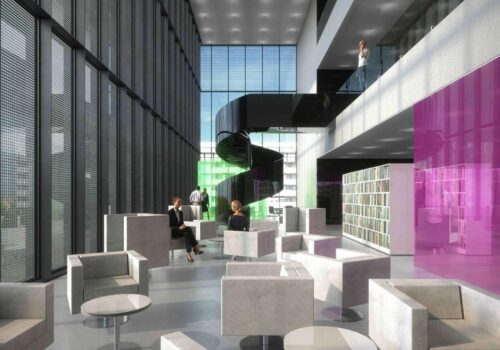The Moravian-Silesian Research Library is currently situated in premises at Ostrava’s city hall. It is used daily by around 900 people, but the premises are too small to handle this number of readers. The basement storage rooms and technical premises also suffer from damp. The storage capacity has already been exhausted, so new acquisitions to the library’s stocks are stored at different locations; this creates substantial complications for the library’s staff. The “Black Cube” – as the proposed new library building is known – will offer ample space for all the library’s stocks (which currently total around 1.2 million items).
Director Libuše Foberová explains the library’s plans: “Our ambition is to provide 21st-century services and to become a valuable educational and community hub. It’s not only about being able to keep all our books under one roof; our aim is also to make the library a creative space where people can meet. We will become a digital library with digital services. The Black Cube project is a guarantee that we will be able to achieve these goals.”
The new library will be located on 28. října Street, opposite the City of Ostrava Cultural Centre.
The history of the “Black Cube” project
In 2004, an architectural competition was announced. The winners – architects Kuba and Pilař created a design for the new library which became known as the “Black Cube”.
In 2008 the Moravian-Silesian Region announced a tender for the construction work, but the bids were far in excess of the expected costs, so the original plans were shelved. The design was reworked to substantially reduce costs.
However, in 2010 the newly elected Czech government revoked its predecessor’s decision to co-finance the project, and work came to a halt.
In 2015 the Black Cube project was abandoned entirely, but the Moravian-Silesian Region was still determined to build a new library, so it began considering other options for the building.
Another turning-point came in 2018 when the original Black Cube project was resurrected and a memorandum was signed agreeing on co-financing for the project: the Region committed to provide 400 million CZK, the state 800 million, and the City of Ostrava 150 million.
Later the state offered to finance only 10% of the costs. However, the Moravian-Silesian Region is currently attempting to access funding from the Just Transformation Fund – a resource available to regions that have been hit hard by the closure of coal mines and the associated economic transition. The expected costs of building are 2 billion CZK. 85% of the planned project costs will be covered by the Transformation Fund; the remainder will be funded jointly by the Region and the City of Ostrava.
The current situation
The Black Cube will in fact be a green library: it will be over 80% self-sufficient in energy, using a system of underground pumps for heating. It will also be highly efficient in its use of rainwater, its smart lighting systems, and its paperless operations.
The new library will be a hugely important hub for education and digitalization, benefiting not only the Moravian-Silesian Region but also neighbouring regions. It will have close links with other European centres, enabling it to become one of Europe’s top libraries. Besides digitalizing its current stocks, it will also provide digitalization services for other regional libraries, museums, and companies.
Although the exterior of the building has hardly changed since the original project was unveiled 15 years ago, the interiors have been completely redesigned. There are fewer offices, fewer books on open display, and more study space. There is also a digitalization centre – the Maker Space, which will enable users to work with robots and virtual reality – as well as a computer teaching room, an art-house cinema and a recording studio.
If everything goes to plan, the subsidy programme should be launched in 2022, and the Black Cube project will be able to move into the construction phase. It should be open to visitors in 2027.
The Moravian-Silesian Research Library and the Black Cube in the media (in Czech)
- 17. 7. 2020 – Stát podpoří koncertní síň i vědeckou knihovnu
- 13. 1. 2020 – Černá kostka bude. Kraj pokračuje s přípravou stavby vědecké knihovny
- 14. 2. 2019 – Černá kostka se vrací na scénu. Otevřít se má v roce 2023!
- 31. 1. 2019 – Černou kostku přepracují a doplní parkovacím domem pro stovky aut
- 26. 4. 2018 – Stát podpoří stavbu Černé kostky v Ostravě
- 15. 3. 2018 – Nové sídlo Moravskoslezské vědecké knihovny bude podle projektu Černé kostky
- 18. 12. 2017 – Černá kostka v Ostravě je stále nejistá, projekt brzdí peníze a parkování
- 9. 10. 2017 – Černá kostka je zpět ve hře, kraj zjišťuje využitelnost původního plánu
- 7. 11. 2016 – Černá kostka v Ostravě má šanci. Nové vedení kraje opráší starý plán


